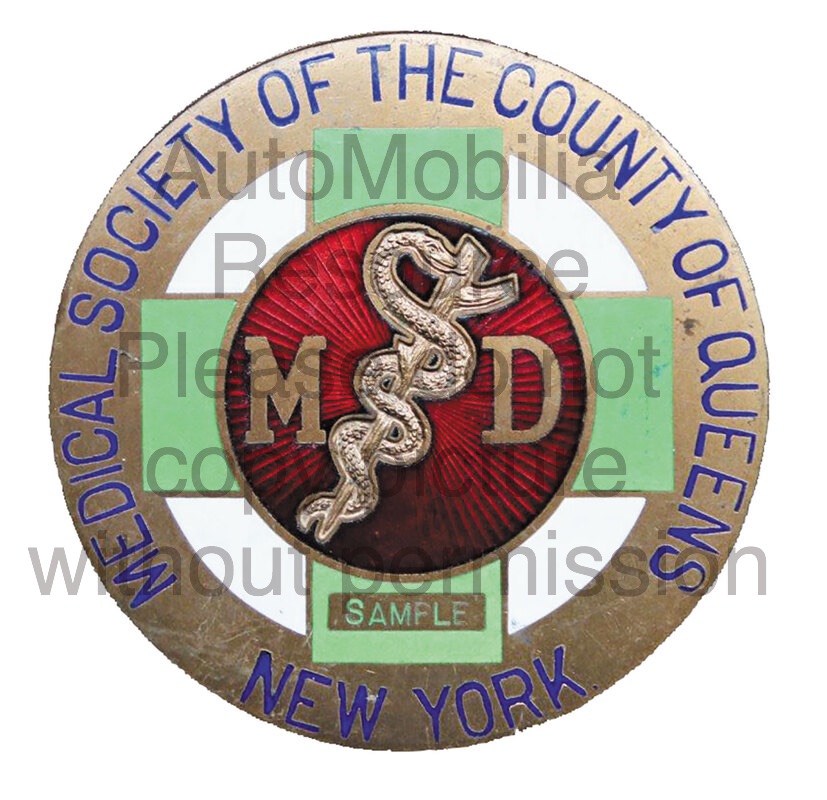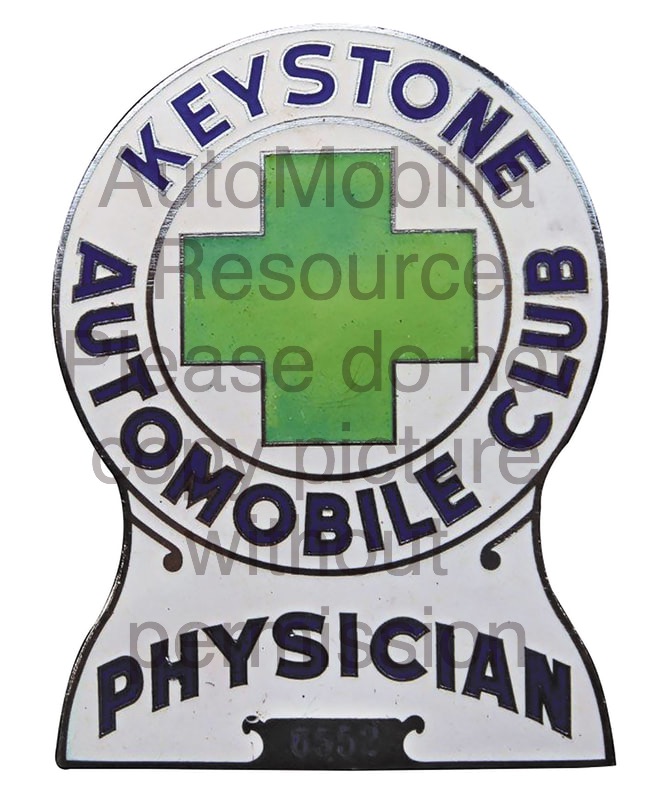|
Nov/Dec 2020 edition Issue #13 AutoMobilia Resource Magazine John & Henri Boggs Dedicated to our Medical workersThere was a time in this country when medical profession badges were proudly displayed on automobiles. These badges identified the automobile owner as a member of the medical community. Many factors have led to their demise, including automobile designs and the lack of an appropriate area to display the badges. Medical badges also disappeared due to liability issues. Medical professionals are now protected by the “Good Samaritan” law or act, but that was not always the case. By the time these laws were passed in the 1980s, badges had given way to window stickers if anything at all was displayed. The badges featured in this article are a small sampling of the medical profession badges that were produced in the past and are by no means all inclusive. Many badges exist for other medical disciplines and offer the collector a wide range of badges in the medical field. We have included price ranges for the badges pictured, but how do you place a value on one’s health and well-being? Invaluable and priceless! Thank you to all of the first responders and medical professionals that help and protect us during normal times and especially during this Coronavirus pandemic. They are on the front lines every day and deserve our heartfelt thanks and gratitude. Stay Safe and Keep on Collecting! John Boggs & Henri Boggs
To read more great columns like this one from car badge experts John & Henri Boggs...
|
| American Motor League: The first United States automobile organization was the American Motor League (AML). The AML was organized at a meeting in Chicago, Illinois November 1, 1895 at the Chicago School of Electricity on Dearborn Street. The organizations purpose was to promote legislation favorable to the rights of automobile owners, and the promotion of better roads. The club logo was a wheel with a wing attached to the hub and as of this writing, no large badge has been found. Due to the club’s short life, the club may have only issued a pin. While there was a lot of interest and support for the AML, there were other competing organizations being formed in these early years which led to the demise of the AML. In 1904 the AML merged with the newly formed American Automobile Association (AAA). |
| Automobile Club of America: Following the formation of the AML, the Automobile Club of America (AC of A) was formed June 8, 1899, in New York City. The AC of A was one of the worlds earliest automobile clubs. The main purpose at the time was social, but expanded to work on legislation more favorable to the early motorists, and to continue the work started by the early bicycle organization, the League of American Wheelman (LAW) to improve roads and promote travel and tours. The club’s early members were also instrumental in forming the American Automobile Association (AAA) in 1902. The earliest AC of A badge was an eagle on top of a wheel and was available in brass or nickel finish. The front side of the badge has the eagle facing forward and the club flag in the center. The reverse side of the badge shows the back side of the eagle and a 46-star American flag, which would date the badge 1907 or later. By the late teens there would likely have been a Boyce Moto Meter mounted on the radiator cap to tell the driver if his engine was overheating, or perhaps a mascot identifying the marque, and another type of AC of A badge would have been fitted to the front of an automobile radiator with wires. These badges were proudly displayed to identify the automobile owner as a member of the organization, and to advertise the club… which no longer exists. |
The AC of A badge above was made by Blackstarr & Frost and is 5.5”x3.5” not counting the cap. It is numbered and is hollow. These early badges sell for $500 and up. Condition is very important and NOS examples command a premium. The early badges were also made by Whithead and Hoag and there are later versions made in zinc die cast. There is also a reproduction in stainless steel.
| As seen on issue 9 cover... This AAA brass badge was the first style adopted by the organization and was in use from 1906-1915. Many of these early badges were made by the Imperial Brass Manufacturing Company, Chicago, Illinois and examples exist with the names of cities and state organizations displayed on a banner beneath the interlocked wheels. Badges would have been given to AAA members and as the styles changed over the years new badges were issued. Many of the old badges were discarded leaving few today. Sized at 4.375”x6” and has lugs on the back side to attach to the radiator with wires. This badge would sell for $200 - $350. |
American Automobile Association:
On March 9, 1902, the American Automobile Association (AAA) was formed. Representatives of nine clubs, met in Chicago to join together to promote legislation for better roads. Motorists had to overcome many obstacles in the early days. Roads were poorly marked and there were few roads outside of cities that were paved. In addition to the poor road conditions, motorists had to contend with a general mistrust and dislike of this new form of transportation. These conditions led to many local car clubs being formed to offer services such as legal help, motorist insurance, break down assistance, maps and travel information. Many of the clubs were also instrumental in erecting signs to mark the highways and streets to assist motorists and to promote touring. In 1906 the newly formed organization adopted as their first official emblem, three capital A’s inside interlocking wheels. Today AAA is one of the largest organizations serving motorists in the U.S.
On March 9, 1902, the American Automobile Association (AAA) was formed. Representatives of nine clubs, met in Chicago to join together to promote legislation for better roads. Motorists had to overcome many obstacles in the early days. Roads were poorly marked and there were few roads outside of cities that were paved. In addition to the poor road conditions, motorists had to contend with a general mistrust and dislike of this new form of transportation. These conditions led to many local car clubs being formed to offer services such as legal help, motorist insurance, break down assistance, maps and travel information. Many of the clubs were also instrumental in erecting signs to mark the highways and streets to assist motorists and to promote touring. In 1906 the newly formed organization adopted as their first official emblem, three capital A’s inside interlocking wheels. Today AAA is one of the largest organizations serving motorists in the U.S.
| The 1923 AC of A badge is 4.5” in diameter and these usually sell for $300 to $500 depending on condition. The earliest known date for this style is 1921 and date plates were issued for each year when membership was renewed. The badges were made from copper or bronze and the color was fired on and is very susceptible to chips and damage. Wires are used to attach to the radiator. |
Many different badge types and styles have been produced over the years with a wide range of prices and categories for the collector to choose from. Examples are state clubs, national clubs, fraternal organizations, medical badges, sports car clubs, and marque club badges such as Chevrolet, Chrysler or Ford to name just a few. These pieces of “automotive jewelry” were designed to convey a message, advertise an organization or identify the car owner as a proud member of an organization. There is potentially something for everyone!
John & Henri Boggs
John & Henri Boggs
To read more great columns like this one from car badge experts John & Henri Boggs...
Subscribe to AutoMobilia Resource

John & Henri Boggs United States State Badge Collection. The US State Badges are from all 50 States and the fired-on enamel badges would sell for $150 to $350 depending on condition and scarcity. More modern badges sell for less. Collectors can usually find badges on eBay, auctions, car events and antique shops.
John & Henri Boggs
John & Henri have been collecting car badges for over 40 years.
jaboggsjr@comcast.net



















 RSS Feed
RSS Feed